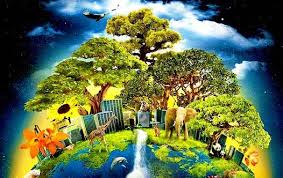If skyrocketing oil prices, the booming world population and the threat of global warming hadn’t already grabbed people’s attention, last week’s record power demand and air-quality warnings certainly served as a reminder that the world faces pressing questions about its climate and energy use.
While “doing something for the environment” once meant tossing a newspaper in a recycling bin or buying organic lettuce, now nearly every aspect of daily life — from the toilets we flush to the flowers that decorate our dinner tables — is being radically rethought. Entrepreneurs, scientists and thinkers are working to transform industry so that it functions more like nature, lessening pollution and inefficiency while moving the economy forward. Well, here are some ideas — some far-fetched and far-off, others thriving right here, right now — that can make the world a greener place.
REUSEABLE E-PAPER:
Paper comes from trees, and trees are worth preserving. (And even though paper can be recycled, it still requires energy to produce and transport it.) The Internet was supposed to kill the printed word, but the pleasure of holding a book, newspaper or magazine has remained unique that is, until recently. At Frankfurt’s Plastics Electronics trade fair last fall, German tech giant Siemens unveiled computer screens that are paper-thin — quite literally — and can transmit moving and still images. The technology can be used for magazine advertisements and computer games, and could eventually replace paper: Publications could take the form of chips or even wireless transmissions, allowing the reader to continually reuse the same set of pages.
FECAL MATTERS:
It may seem a mere nuisance to city dwellers, but animal waste needn’t go to waste. In San Francisco, dogs produce as much as 6,500 tons of the stuff per year; what doesn’t end up wrapped in plastic bags for all eternity can leach its unfriendly bacteria into the sea or the water supply. A pilot program in which droppings from one busy dog park are collected with biodegradable bags and processed by a machine called a methane digester, in which bacteria process the feces, is being initiated.
PLASTIC FROM PLANTS
Plastic is one of the most useful materials, but also one of the most environmentally problematic. While its light weight saves fuel in cars and during shipping of goods, most plastics are produced using petroleum and toxic chemicals. When burned, as some garbage is, more toxic compounds are released.
The new breed of biodegradable and plant-based plastic containers and tools offer almost all of plastic’s benefits and few of its ecological drawbacks.
BIOFUELS
Biodiesel — one of the green movement’s biggest buzzwords — is diesel fuel derived from a combination of alcohol and animal or vegetable fats, instead of petroleum. Diesel cars and trucks can run on it without any conversions, and while burning biofuels still produces carbon dioxide, the levels released are much lower, the exhaust contains fewer carcinogens and growing the crops to produce it actually absorbs carbon dioxide.
Commercial biodiesel may be more expensive than regular diesel or gasoline, but the fuel economy is significantly better.
COMPOSTING TOILETS
Though you probably want what’s in your toilets to go far, far away, composting toilets — which trap waste to produce fertilizing mulch — make a lot of environmental sense. Instead of sending waste into the sewer system, the air-suction driven, mostly waterless toilets store it in a hidden, sealed chamber, where air circulates to decompose the material in a peat moss base. Microbes and worms help with the process. Users remove the final product — rich, garden-ready fertilizer — every few months.
GREEN BURIALS
Yes, even returning to the earth can be done in a more earth-friendly way. Traditional funerals place chemically embalmed bodies in sealed containers, while cemeteries require not-so-green upkeep in the form of gasoline-powered lawn mowers and chemical grass fertilizers. And coffins, after all, are made of wood from trees. Green burial sites feel more like nature preserves, and that’s the idea: Practitioners emphasize the use of biodegradable, renewable-material coffins (or none at all), natural stones over headstones, and the planting of flowers and trees. An added bonus: It’s significantly cheaper.
All these methods are on a large basis. But that shouldn’t stop an individual by doing whatever he can to make the environment better and greener. Well, here are some additional tips for that. :
- Look for ways to Save Water around the house
- Grow your own food.
- Lesser dependencies on fossil fuels (as mentioned earlier).
- Get around green (walking or using your bicycle inplaceof the car).
- Having a plant or two in your house, not only does it help the environment but it is healthy as well.
- Communing with nature is more resource-friendly than going to the movies or restaurant or mall.
- Always remember the three R’s- Reuse, Recycle and Reduce.
This is what I can think of right now and I hope this helps. Now, what do you think of the environment? Do you think it will be safe again? These questions go around all day in your head. Think about it. Think about the answers. Together, we can keep our Earth clean! Go Green!




Leave a Reply